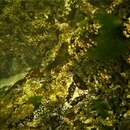en
names in breadcrumbs


Scartichthys gigas és una espècie de peix de la família dels blènnids i de l'ordre dels perciformes.
És un peix marí de clima tropical que viu entre 0-10 m de fondària.[4]
Es troba des de Panamà fins al nord de Xile.[4] [7][8]
És emprat per preparar una sopa anomenada borracho, la qual provoca cansament i una intoxicació lleu, tot i que aquests efectes són de curta durada.[9]
Scartichthys gigas és una espècie de peix de la família dels blènnids i de l'ordre dels perciformes.
Scartichthys gigas, the giant blenny, is a species of combtooth blenny found in the eastern Pacific ocean, from Panama to northern Chile. Members of this species feed primarily off of plants (including benthic algae and weeds), crustaceans, and small mollusks and they themselves are seldom caught for human consumption, as their meat is tasteless. It is said that they can be made into a mildly narcotic soup, therefore their Spanish name borrachilla (drunk). This species reaches a length of 22.2 centimetres (8.7 in) SL.[2]
Scartichthys gigas, the giant blenny, is a species of combtooth blenny found in the eastern Pacific ocean, from Panama to northern Chile. Members of this species feed primarily off of plants (including benthic algae and weeds), crustaceans, and small mollusks and they themselves are seldom caught for human consumption, as their meat is tasteless. It is said that they can be made into a mildly narcotic soup, therefore their Spanish name borrachilla (drunk). This species reaches a length of 22.2 centimetres (8.7 in) SL.
El borracho (Scartichthys gigas) es una especie de pez de la familia Blenniidae en el orden de los Perciformes.
Los machos pueden llegar alcanzar los 22,2 cm de longitud total.[2][3] Perfil anterior de la cabeza redondeado o muy convexo; coloración variable, con manchas reticuladas o 2 líneas o bandas a lo largo del cuerpo, una mancha oscura detrás del ojo y otra al comienzo de la aleta dorsal, entre la primera y tercera espinas dorsales, a veces manchas que pueden formar bandas verticales sobre el cuerpo, aleta dorsal con el borde blanco. Aleta anal con 16 radios; aleta dorsal larga y muy muesqueada; con una porción espinosa casi de igual longitud que la porción blanda; con 12 espinas y 16 a 18 radios. Cirros orbitales presentes. Piel lisa, sin escamas y rica en elementos glandulares secretores de mucina. Aletas ventrales de posición yugular reducidas a sencillos bastoncitos cartilaginosos. Los ejemplares juveniles tienes coloración variada, siendo la más común, la amarilla de fondo, con dos rayas horizontales oscuras y asociadas a éstas, innumerables manchas de un tono amarillo claro.
Es ovíparo de puesta en sustrato.
Es un pez de mar y de clima templado que vive entre 0-40 m de profundidad. Vive cerca de la costa en fondos rocosos de preferencia con abundantes algas. En Perú y Chile es uno de los peces más abundantes en el litoral y habitualmente se le encuentra en grietas de rocas cohabitando con crustáceos pequeños. Con frecuencia se le observa con un temperamento ansioso y territorial.
Se encuentra en el Pacífico oriental, desde Panamá hasta el norte de Chile.
El borracho (Scartichthys gigas) es una especie de pez de la familia Blenniidae en el orden de los Perciformes.
Scartichthys gigas Scartichthys generoko animalia da. Arrainen barruko Actinopterygii klasean sailkatzen da, Blenniidae familian.
Scartichthys gigas Scartichthys generoko animalia da. Arrainen barruko Actinopterygii klasean sailkatzen da, Blenniidae familian.
Scartichthys gigas is een straalvinnige vissensoort uit de familie van naakte slijmvissen (Blenniidae).[2] De wetenschappelijke naam van de soort is voor het eerst geldig gepubliceerd in 1876 door Franz Steindachner.[3] Hij gaf aan de soort de naam Salarias gigas.
De soort staat op de Rode Lijst van de IUCN als niet bedreigd, beoordelingsjaar 2007.[1] Ze komt voor in de oostelijke Stille Oceaan, van Panama tot Chili. De vindplaats van Steindachners specimen was Callao (Peru). De dieren kunnen ongeveer 22 centimeter lang worden.
Bronnen, noten en/of referenties